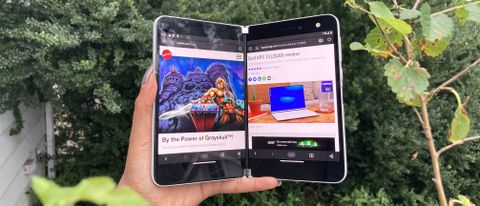Laptop Mag Verdict
The Microsoft Surface Duo is the world’s thinnest foldable device with incredible app-juggling features, but its UI needs tweaking.
Pros
- +
Double-app productivity
- +
Fun drag-and-drop features (e.g. spanning)
- +
Revolutionary 360-degree hinge
- +
Portable, thin and light
- +
Colorful displays
Cons
- -
No headset jack
- -
Middling performance
- -
Poor UI fluidity
- -
Pricey
Why you can trust Laptop Mag
Price: $1,499
CPU: Qualcomm Snapdragon 855
RAM: 6GB
Storage: 256GB
Display: 5.6-inch dual-screen, AMOLED
Battery: 9 hours and 27 minutes
Size: 5.7 x 7.4 x 0.18 inches
Weight: 0.5 pounds
The Microsoft Surface Duo (starting at $1,399, reviewed at $1,499) was the first device I wrote about as a staff writer at Laptop Mag. Sassily titled “Microsoft’s Surface Duo flipping in this video tickles my toddler-like attention,” the article captured how much I drooled enviously over a leaked Surface Duo video. The Duo was transforming like Optimus Prime and I was hooked.
Seven months later, I now have the Surface Duo in my hands — and that title couldn’t have been more fitting.
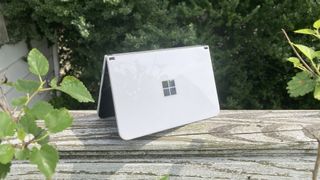
This phone, tablet, pocket computer — whatever you want to call it — is for us multitasking masters. If you want to watch Netflix and browse the Web simultaneously, you can do that. If you want to host a Zoom call while reading a Microsoft Word document, you can do that, too thanks to the Surface Duo’s dual-screen design.
But don’t mistake my excitement for praise. I’m critical of Microsoft’s first-gen Surface Duo. The inconsistent interface is a pain in the ass, swipe controls can be unresponsive, and the screens’ bezels are too thick. Still, I can’t deny that the Duo is a trailblazing device that pushes the envelope of versatility and productivity.
Microsoft Surface Duo price and configuration options
The Surface Duo starts at $1,399 and is equipped with a Qualcomm Snapdragon 855 processor, 6GB of RAM, 128GB of storage and dual 5.6-inch, 1800 x 1350-pixel displays.
Our review unit costs $1,499, which bumps up the storage to 256GB.
Microsoft Surface Duo design
The Surface Duo’s svelte form factor is so compact and portable, if you spotted the phablet on someone’s desk, you’d likely assume it’s a small book or a tiny white purse.
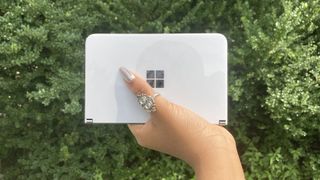
Speaking of purses, I was able to snugly slip the Surface Duo inside the pocket of my favorite handbag.
Good genes run in the Surface family and the Duo inherited its descendants' stately, clean-cut, minimalist aesthetic. The glossy exterior has a conservative design with an ivory-white finish. You’ll find Microsoft’s reflective, silver logo on the front cover of the Surface Duo.
The interior of the Surface Duo features two 5.6-inch screens that expand into an 8.1-inch tablet.
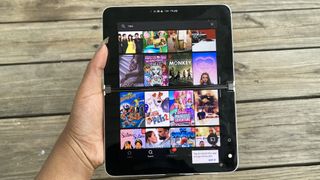
Two sturdy hinges connect both hemispheres mechanically and electrically to provide 360 degrees of rotation. What makes these hinges extraordinary is that opening and closing the Surface Duo feels fluid and effortless, but there is enough friction and stability to stop at any position. The folks at Microsoft told me that the hinges route ultra-thin wires that carry data, power and control signals between the two displays. How thin are these wires? They’re as tiny as a human hair strand!
Now let’s talk about the display — boy, are these bezels thick!

While the side bezel is relatively slim, the top and bottom bezels are large, making the Surface Duo appear outdated for a 2020 device. Perhaps the Microsoft engineers faced hardware limitations that thwarted them from implementing a bezel-free design, but I refuse to coddle the Redmond-based tech giant. There must be a way to ditch those dated bezels for a sexier, more modern design. Needless to say, I’m hoping the second-gen Duo has smaller bezels.
The unbelievably thin-and-light Surface Duo has dimensions of 5.7 x 7.4 x 0.18 inches when opened and weighs only 0.5 pounds. The Duo is slimmer than its fiercest competitors: the Apple iPhone 11 Pro Max (0.32 inches thin, 0.5 pounds) and the Samsung Galaxy Z Fold 2 (0.27 inches thin, 0.6 pounds).
Microsoft Surface Duo ports
The Surface Duo sports a USB 3.1 Type-C port — and er — that’s really it. Don’t expect to find a headset jack on this pricey phablet. Microsoft had a tunnel-vision plan to maintain the Duo’s thinness, so the headset jack — and other ports — had to be scrapped.

Despite the missing headset jack, you can still opt for USB Type-C headphones or wireless earbuds that can connect via Bluetooth. The Surface Earbuds are a decent option for the Duo.
Microsoft Surface Duo modes
The Surface Duo can rotate into numerous useful positions, including tablet mode, tent mode, compose mode, book mode and peek mode.
Tablet mode is best for maximizing your screen real estate. To take advantage of this feature, you’ll have to “span” apps and web pages across both displays using a simple drag-and-drop maneuver to the divider.

If you’d like to read a long-form news article, for example, you can span the Web page across both screens and rotate the device into a horizontal position so the displays are in a top-and-bottom orientation (as opposed to side-by-side). From there, you can feast your eyes on the expansive reading territory — right in the palm of your hand.
I was floored by the extra screen real estate as I read a New York Times article on the expanded 8.1-inch tablet. The number of times I had to scroll dropped drastically thanks to the Duo’s tablet-mode orientation. The Surface Duo is a fitting device for on-the-go tech enthusiasts who love reading during their commute.
Tent mode transforms your Surface Duo into a mini-entertainment center.
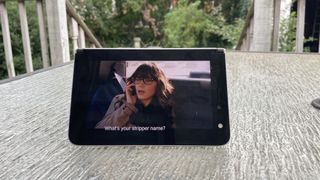
You can enjoy a hands-free viewing session while watching your favorite videos on YouTube, Netflix, Twitch and more. I loved propping the Surface Duo on my nearby nightstand. At bedtime, I’d rewatch episodes of New Girl in tent mode and Schmidt’s hilarious one-liners would lull me into a deep, restorative sleep.
Compose mode is the optimal orientation for texting and typing on the Duo.
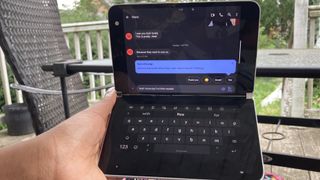
I should add that the keyboard on this device is not the most comfortable for users with small hands. Reaching for characters in the middle of the keyboard required a little more finger stretching than I’m accustomed to. On the plus side, the haptic feedback you get while pressing on the digital keyboard is quite satisfying.
Book mode is the position best for app juggling. I had a ball experimenting with numerous app combinations.

I launched Spotify on one side and scrolled through Instagram on the other. The experience of listening to my favorite songs while scrolling through my social media feed was beguiling. I also sifted through a news app on the right display and YouTube on the left display. The app combinations are endless! The double-app experience on the Surface Duo is bewitching — it’s the phablet’s greatest selling point.
Peek mode is one of my favorite postures.
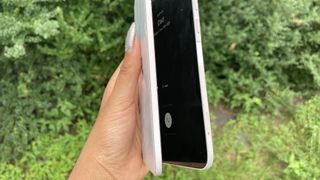
When someone calls, you can open the Surface Duo ever-so-slightly to see who’s calling, and if you don’t like the caller, you can slam the device shut and the call will remain unanswered.
Microsoft Surface Duo display
The Surface Duo features two 5.6-inch, AMOLED displays covered in Corning Gorilla Glass. A single display offers a 4:3 aspect ratio and 1800 x 1350-pixel resolution. As an 8.1-inch tablet, you get a 3:2 aspect ratio and 2700 x 1800-pixel resolution.
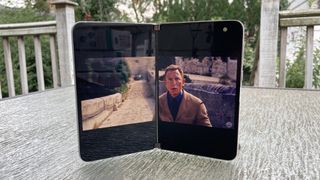
When I watched the No Time to Die trailer, I wasn’t particularly blown away by the displays’ quality — the panels are not as crisp as I expected them to be for a $1,499 device. I couldn’t spot the minute features you’ll see on sharper displays, but after Daniel Craig swung off a bridge on a flimsy rope, I could make out his laugh lines, crow’s feet and subtle forehead wrinkles.
There was something hypnotizing about watching the trailer “bend” before my very eyes. Watching a luxury car fold like origami between the divider was captivating.
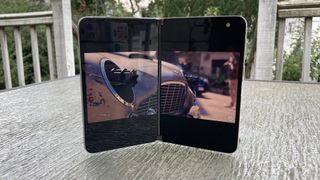
Still, as fun as the Surface Duo’s bendable qualities are, I often found myself saying, “Hey divider! Get out of the way!” as it blocked actors’ and actresses’ faces. You can always transfer the video to a single screen to avoid the irksome divider, but then you’ll miss out on that tablet-like viewing experience.
The Duo’s dual displays achieved high-flying scores on our colorimeter. The Surface Duo has two display options: vivid (default) and sRGB.
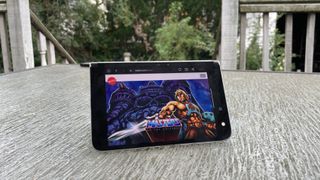
With the vivid option, the left screen covered 199% of the sRGB color gamut while the right screen covered 196%. But when sRGB was ticked on, the left screen covered 134% of the sRGB color gamut and the right screen covered 132%. The $139% color coverage of the average smartphone bests the Duo’s sRGB option, but not its vivid mode.
The Duo’s screens are more colorful than the iPhone 11 Pro Max (119%). The Samsung Galaxy Z Fold 2, like the Duo, also has two display options: natural (default) and vivid. The Galaxy Z Fold 2 is less colorful than the Duo when natural mode is on (122%), but its vivid option is true to its name, offering a jaw-dropping color-coverage score of 206%.

At 458 nits of brightness, the Duo’s screens are dim compared to its competitors. The average smartphone emits 540 nits of brightness while the iPhone 11 Pro Max is as bright as a diamond and outshone the Duo with a whopping 761 nits of brightness. We tested the Galaxy Z Fold 2’s screen brilliance in two states: with adaptive brightness on and with adaptive brightness off. With the former, the Galaxy Z Fold 2 emitted 599 nits of brightness. However, with the latter, the Galaxy Z Fold 2 output only 361 nits of brightness — in this case, the Duo surpassed its Samsung rival.
Microsoft Surface Duo performance
Sporting a Qualcomm Snapdragon 855 processor and 6GB of RAM, the Surface Duo is a foldable firecracker — the phablet endured my deluge of 20 Google Chrome tabs on the left screen while I watched Sister, Sister on Netflix on the right display. The Duo didn't show any signs of stuttering, but it’s worth noting that the device started to get a little toasty.
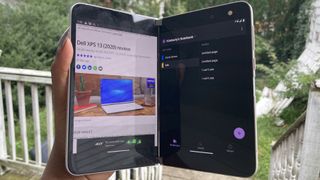
The Surface Duo offered middling performance scores on our synthetic tests. On Geekbench 5, which tests overall performance, the Surface Duo achieved 2,862, short of the category average (2,874). The Duo also paled in comparison to the mighty iPhone 11 Pro Max (3,517). The Galaxy Z Fold 2 also crushed the Duo with a score of 3,310.
On our Jetstream benchmark, which tests how quickly Web pages load, the Surface Duo achieved a measly score of 70, which is lower than the average smartphone (109), the iPhone 11 Pro Max (152) and the Galaxy Z Fold 2 (74).
Perhaps the Surface Duo would perform better if it had a newer chip — the Snapdragon 855 CPU is a bit outdated.
Microsoft Surface Duo battery life
The Microsoft Surface Duo features two 3577 mAh batteries — one for each screen. The Redmond-based tech giant boasted that the Duo lasts 15 hours and 30 minutes while running local video playback. This result, however, isn’t representative of real-world usage.
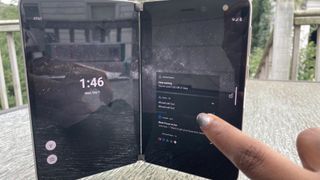
We ran two battery life tests on the Surface Duo, which involved continuous web surfing over Verizon’s network at 150 nits of brightness. The device lasted an average of 9 hours and 27 minutes. That is almost a half-hour shorter than the average smartphone (10:24). The Surface Duo also got smoked by the iPhone 11 Pro Max (11:44) and the Galaxy Z Fold 2 (10:10).
Microsoft Surface Duo audio
I opened the Spotify app and listened to “I Love You Baby” by Surf Mesa. I don’t really have anything negative to say about the audio. The sweet-sounding, romantic melody filled my medium-sized testing room at max volume. The music sounded vivid and crisp, but lacked that rich, dynamic audio you may find on other devices with higher quality speakers.
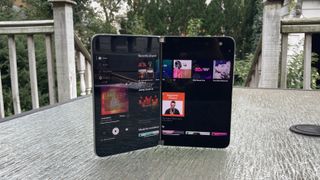
There’s no sign of speakers on the outside of the device, but I could hear audio blasting from the upper-left corner of the left hemisphere.
Microsoft Surface Duo camera
The Surface Duo’s 11-megapixel camera, located on the right screen’s top bezel, doesn’t have industry-leading specs, but as a reviewer who’s been tortured by the laptop industry’s awful webcams, the Duo’s high-definition camera was a breath of fresh air.

It does a particularly great job of reproducing accurate colors. It correctly captured my brown complexion and I could even spot tiny pieces of lint on my ribbed black top. I also took pictures in my backyard and my neighborhood — the images were vibrant, but the camera is nothing to write home about.

The Surface Duo’s f/2.0, 1.0µm camera offers 4K video recording at 30 frames per second and 1080p video recording at 60 frames per second. The 84-degree field-of-view camera also features auto mode with low-light, HDR multi-frame photo capture, dynamic range scene detection and 7x “super zoom. The single camera can be used for selfies or as a rear-facing camera when you fold the Duo in half. In this orientation, the left screen becomes a viewfinder.
Microsoft told reviewers that while the Surface Duo’s camera is good, the tech giant wanted to focus its investment on creating a device that could redefine the mobile productivity market.

Microsoft Surface Duo interface
Let’s just get to the point: the Surface Duo’s interface needs improvement.
First, let’s talk about the positives. Dragging and dropping apps onto the screen I wanted was a seamless experience. Exiting apps was a breeze, too — all I needed to do was flick the app toward the top bezel and it would disappear.
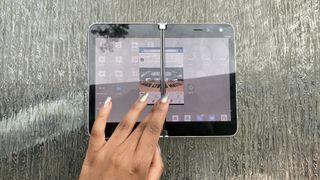
I also enjoyed using a feature called App Groups, which lets you pair two favorite apps together for simultaneous launching. You can, for example, pair Instagram and Twitter in an App Group, and with one tap, the social-media apps will launch at the same time. Spanning, which requires dragging and dropping apps to the divider, worked like a charm, too.
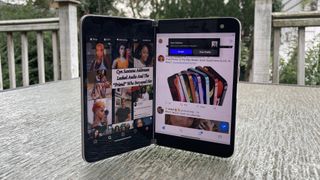
However, other operations lacked fluidity. For example, swiping the bottom taskbar’s icons from the left screen to the right screen — and vice versa — lacked responsiveness. It took a couple of swipes before the Duo “reacted” to my gestures. I sometimes had trouble unlocking the home screen with my swipes.
On top of that, Microsoft boasts that you can watch a video or read a book on one side while taking notes on the other, but unfortunately, the keyboard takes up the whole display and I couldn’t see what I’m typing.

If Microsoft can rectify some of the Duo’s wonky interface issues, it will have a star on its hands. When I informed the Microsoft team about these bugs, they assured me that future updates will resolve the UI hiccups. I’m not sure if these updates will fix the Duo’s interface defects, but I do have hope for the Redmond-tech giant. It’s easy for me to point out flaws as a reviewer, but I can’t imagine how difficult it must be for software engineers to achieve UI nirvana in the nascent realm of foldables. Despite the Duo’s flaws, I still applaud Microsoft for taking a leap of faith into the pool of innovation.
Microsoft Surface Duo software and warranty
The Surface Duo runs Android 10. Its pre-installed software is a beautiful melange of Microsoft and Google apps. One standout program you’ll get from Microsoft is the Your Phone companion app, which allows you to link your Duo to a Windows device. With Your Phone, you can sync texts, calls and notifications directly to your desktop.
From Google, you’ll get pre-installed apps such as YouTube, Gmail, Chrome, Drive and more.
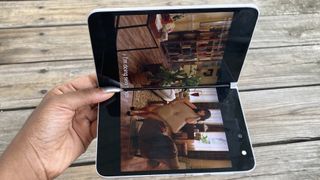
This Surface Duo is a new interaction model for many, and consequently, there is a bit of a learning curve. That’s why I found the Tips app to be particularly useful — it offered some much-needed guidance on how to use this innovative phablet.
The Surface Duo comes with a one-year limited warranty. See how Microsoft did on our Best and Worst Brands and Tech Support Showdown special reports.
Bottom line
The Duo doesn’t know whether it’s a phone, tablet, high-tech Kindle alternative or a pocket-friendly computer, but that’s what makes the Surface Duo so endearing. The Duo challenges conventional thinking — does the Duo really need to fit into a box? The Duo’s “identity,” in my opinion, is being a funky foldable that doesn’t want to be pigeonholed.
The Microsoft Surface Duo, from the standpoint of innovation and inventiveness, is a divine dual-display device. It merges the eminence of Windows with the omnipresence of the Android ecosystem into one tiny, unbelievably thin phablet. It offers an incredibly entertaining double-app experience and features a 360-degree hinge that can rotate to any position you can think of.
But that interface, though.

Once Microsoft enhances the UI to become more responsive and intuitive, the Surface Duo could become unstoppable in the foldable space. But until then, I’d wait for the next Surface Duo update before investing in this phablet. The Galaxy Z Fold 2 is $500 pricier than the Surface Duo, but it offers longer battery life, a brighter display and better performance. Still, despite the Duo’s flaws, it's a titillating tech marvel that — once all the kinks are ironed out — would be great for on-the-go bookworms and Netflix enthusiasts who enjoy hands-free, portable entertainment.
Kimberly Gedeon, holding a Master's degree in International Journalism, launched her career as a journalist for MadameNoire's business beat in 2013. She loved translating stuffy stories about the economy, personal finance and investing into digestible, easy-to-understand, entertaining stories for young women of color. During her time on the business beat, she discovered her passion for tech as she dove into articles about tech entrepreneurship, the Consumer Electronics Show (CES) and the latest tablets. After eight years of freelancing, dabbling in a myriad of beats, she's finally found a home at Laptop Mag that accepts her as the crypto-addicted, virtual reality-loving, investing-focused, tech-fascinated nerd she is. Woot!
